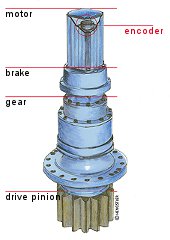
From a soft breeze to a strong gale – wind energy plants are exposed to strongly fluctuating wind forces and have to use them as efficiently as possible. To increase their efficiency, dynamic pitch control is used to adjust the rotor blade to the required angle. At low wind speeds, the rotor blades are directed towards the wind and turned away again as the wind forces increase, so as to ensure that the wind turbine continues to operate safely even at high wind speeds. Just as for many applications involving rotational movements, there are different approaches enabling the use of encoders – starting from simple solutions with only one incremental encoder right through to a combination of two redundant absolute encoders. Below is a description of the various installation types for encoders determining the pitch control.
An axis for the positioning of a rotor blade consists of a drive pinion, gear, brake, motor and encoder (see sketch).

The gear motor positions the rotor blade, and an additional brake ensures that the required position is maintained safely even in case of a power failure. Now, what are the special requirements which a sensor has to fulfill within this system? Since the encoder is directly mounted on the drive, it has to return reliable positioning values within the temperature range from -40 to +100 °C. As far as this requirement is concerned, the optical gear-based multiturn encoders Acuro AC58 offered by HENGSTLER have proven to be the best and most suitable solution. The position is determined by means of an optical rear-illumination method. The mechanical multiturn gear is also scanned optically, so that it is not necessary to test the magnetic effects which may be caused by the drive brakes, in particular. The chosen form of scanning is not susceptible to magnetic interference and therefore suitable for direct mounting on all motors that are provided with brakes. In addition, the encoder offers high resolution values and is able to indicate both absolute and incremental signals, which can be used as reference values and/or for speed adjustments. As a result, no additional resolvers or tachometers are necessary.
Another alternative is to mount the encoder directly on the slewing ring of the rotor blade. In this case, it is coupled by means of a cogwheel mounted on the encoder shaft. Since the mechanical stresses on the sensor are significantly higher than in the case of motor installation, this application puts totally different demands on the encoder. To reduce the encoder bearing load, bearing modules were frequently used in the past. This installation variant calls for a specifically robust encoder, such as Acuro AR62. Excelling with a compact design and extremely sturdy ball bearings, it is suitable for very high axial and radial loads. With a max. admissible load of 300 N (both axial and radial), it not only surpasses most of the common load module types, but also offer 10 times the load capacity of that of commercially available encoders. Similar to AC58 (see below), sensor AR62 is an electronic multiturn encoder, which also exhibits wear-free pulse-wire technology. Magnetic single-turn and multiturn scanning ensures high shock and vibration resistance. In addition, these sensors are resistant to environmental influences, such as humidity and wide temperature ranges. Offering protection class IP69K, this encoder type is suitable for complete outdoor installation.
Finally, the encoder can also be mounted to a limit switch box. On-site installation is facilitated by a complete, pre-adjusted component assembly. In this approach, the mechanical requirements are not as high as compared to the direct installation on the rotor blade. Meeting all the demands for high precision and sturdiness, the magnetic absolute encoder, Acuro AC58, remains a cost-efficient solution regarding its mechanical design. Both in the single-turn and multiturn variant, this encoder type only needs one single magnet. The multiturn encoder uses pulse-wire technology, which means that it works completely wear-free without battery and gear. The energy required for position detection is produced from the rotational movement alone – a significant advantage of this technology.
Depending on the specific application, each encoder type has to meet specific requirements. Encoders designed in “classical” drive technology are needed directly on the motor, for example. These sensors have to offer a wide operating temperature range, high resolution and speed range. Encoders mounted on the rotor blade have to be mechanically sturdy. The Acuro product family offers the right type of sensor for any type of application (see diagram)..